As the visual economy matures, a new report from digital experiences firm Cloudinary investigates the ways more than 375 leading brands across 13 vertical industries harness visual media to deliver engaging online experiences at every digital touchpoint. The research also reveals that businesses must optimize visual media to meet a wide and ever-changing range of business goals, including faster time-to-market, improved productivity and cost savings, and new priorities like accessibility and sustainability.
The firm’s fourth annual State of Visual Media Report offers a look into the way in which brands continue to respond to an increasingly competitive and challenging economic environment by moving beyond simple scalability goals, emphasizing the need to react to new trends and market conditions, fast. This year’s report offers data, use cases and tips on how to meet these requirements and react to new trends so that visual media is a catalyst for growth, not a bottleneck.
Key takeaways include:
Managing for scale and new formats key
Image consumption was up by 25 percent and video traffic continued to increase significantly across industries including retail, which saw video volume grow by 37 percent. From March to May 2022, the lightweight WebP was the most popular image format, accounting for 59 percent of image requests but consuming just 35 percent of all bandwidth. In contrast, JPEG remained the most widely supported and still the largest bandwidth consumer at 38 percent, but it only accounted for 23 percent of all requests.
In e-commerce, epic scale has become the new normal
Beyond the huge increase in image traffic over the year, e-commerce brands saw a massive growth around Black Friday. Large e-commerce brands saw image bandwidth grow by 186 percent compared to their average annual traffic while small and medium brands experienced peaks up to 415v. For video the trend was flipped: video traffic remained quite steady over the year for smaller brands, whereas bigger e-commerce brands saw their video volume increase during Black Friday. In one case, video traffic increased more than 35 percent from 20TB a week to 52TB over the peak holiday shopping period, Black Friday through Cyber Monday.
Speed and flexibility demand a new, composable IT architecture
Brands today must have tech stacks that support change, adaptability and flexibility. The travel industry, for example, saw a more than 50 percent increase in video usage as part of the post-pandemic recovery. Accordingly, the study found a striking rise in the number of customers including River Island, Paul Smith, Rapha and many others, adopting a MACH architecture (Microservices based, API-first, Cloud-native SaaS and Headless) over the same period last year. According to a recent survey from the MACH Alliance, 47 percent of tech leaders are aspiring to move from monolithic deployments to best-of-breed, composable software and 79 percent strongly intend to add more MACH components to their architecture in the future.
Social platforms like TikTok continue to rise, Facebook and Pinterest see declines
When serving images to social media channels, the data shows an ever-changing situation: one platform can peak one month and dip the next. Overall, Facebook remains the number one social media channel (more than 154 billion image requests), followed by Instagram (74 billion image requests) and Pinterest (51 billion requests). However, the requests for Facebook and Pinterest are both continuously declining, while Instagram remains stable and TikTok is rising. Comparing April 2021 with April 2022, Facebook requests declined by 23 percent and Pinterest by 79 percent while Instagram gained two percent and TikTok shot up by 67 percent.
Image and video optimization path to meeting sustainability goals
The report reveals a growing interest from brands to use image optimization to reduce bandwidth not only for improving their performance but to support their sustainability goals as well. Transferring 1 GB of data produces roughly 3 Kg of CO2, so everything that reduces bandwidth brings down the CO2 footprint of a website or app. For example, a top international sports apparel brand was able to reduce bandwidth consumption by 40 percent from 6.8 TB per day to 4.05 TB per day. Annualized, the company saved 618 TB of bandwidth, saving 1,890 tonnes of CO2, which is equivalent to removing more than 400 gas-powered cars from the road.
“Our extensive data illustrates how visual media, if handled well, serves brands as a catalyst for growth, rather than a bottleneck,” said Tal Lev-Ami, co-founder and CTO at Cloudinary, in a news release. “Brands today also need to be much more flexible and responsive than ever. Whether it’s being able to launch new TikTok campaigns or to enable complex Direct-to-Avatar (D2A) commerce in the Metaverse. We’re also seeing more customers turn to open, composable platforms to support their need for agility and a broad range of media use cases.”
Download the full report here.
The data analyzed for Cloudinary’s 2022 State of Visual Media Report comprises engagement patterns during March 2021 through May 2022 and a representative sampling of more than 219 billion transactions per month, across more than 375 Cloudinary customers, spanning 13 vertical industries including education, financial services, food and drink, manufacturing and automotive, marketing and ad tech, media and entertainment, retail and e-commerce, software and technology, and travel and recreation.











